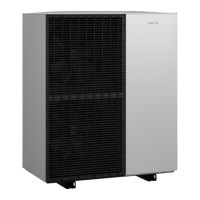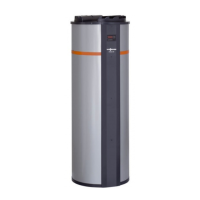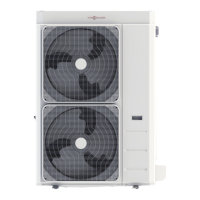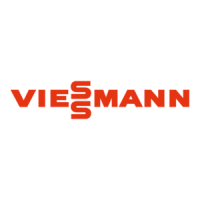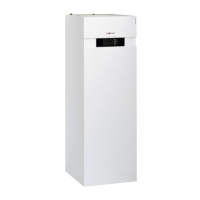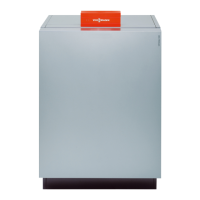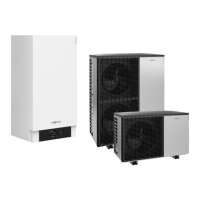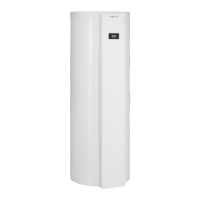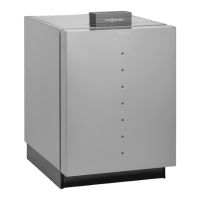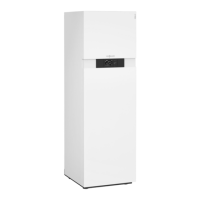Do you have a question about the Viessmann VITOCAL 151-A and is the answer not in the manual?
General safety advice and precautions to prevent accidents and material losses.
Explanation of safety symbols like Danger and Note.
Defines intended users, including children and individuals with reduced capabilities.
Precautions for working on the system, including safety zones.
Specific rules for preventing fire and explosion in the safety zone.
Guidelines for connecting and commissioning the system by authorized contractors.
Guidelines for performing adjustments and work on the system components.
Notes on using tested components to avoid system damage.
General safety rules and precautions for operating the system.
Critical safety steps to take in case of refrigerant leakage.
Instructions on how to handle ice formation on the outdoor unit.
Safety requirements and precautions for the placement of the indoor unit.
Defines the safety zone around the outdoor unit and its specific requirements.
Guidelines for positioning the outdoor unit in relation to external walls.
Specific safety zone rules for right-hand corner installations.
Safety zone requirements for freestanding outdoor unit installations.
Specific safety zone rules for left-hand corner installations.
Details limitations of liability concerning system use and accessories.
Explanation of symbols used in the manual and on the heat pump.
Specifies the appliance's purpose and prohibited uses.
Overview of the heat pump system components and their functions.
Description of the control unit, touchscreen, and communication modules.
Specifies the temperature limits for the indoor installation room.
Defines the operating temperature range for the outdoor unit.
Information on the Viessmann remote diagnostic support service.
Details on wireless data transfer using low power radio.
Information regarding third-party software licenses used in the product.
Process of system setup, matching to local conditions, and user instruction.
Overview of the default factory settings for room heating, DHW, and frost protection.
Advice and tips for reducing energy consumption in the home.
Guidance on achieving optimal comfort levels in the home.
Methods to reduce the noise level of the air source heat pump.
Using excess power from the utility for the heating system.
Ensuring adequate hot water supply based on habitual routines.
General overview of the system's operational principles.
Instructions on how to use the touchscreen interface for settings.
Explanation of the Lightguide indicator's meaning and status.
Overview of different screen displays like standby and default.
Description of the display when the controls are not operated.
Accessing key settings and checks via default display screens.
How to call up and set the home screen display.
Explanation of the various buttons and symbols used in the interface.
Specific buttons and symbols found in the menu bar.
Specific buttons and symbols found in the function area.
Specific buttons and symbols found in the navigation area.
Structure and how to access the main menu for system settings.
List of all available menus and their functions within the main menu.
Setting operating programs for heating, cooling, and hot water.
Description of special functions like screed drying and holiday programs.
Step-by-step guide on how to input and configure time programs.
Understanding how time programs divide the day into distinct phases.
Detailed steps for defining start and end times for each time phase.
Efficiently duplicating time programs to multiple days.
Modifying the start, end, or temperature settings of existing time phases.
Removing specific time phases from a program.
Accessing room heating and cooling settings and checks.
Accessing domestic hot water (DHW) settings and checks.
Monitoring the energy status and components of your heat pump.
Viewing performance metrics like SCOP, SEER, and energy generation.
Displaying power consumption of the heat pump and booster heater.
Customizing the display by selecting and adding preferred menus.
Steps to select and add menus to the Favourites display.
Checking current system data such as pressure, temperatures, and status.
Accessing further system data and contractor contact details.
Choosing the specific heating or cooling circuit to configure.
Adjusting standard, reduced, and comfort room temperatures.
Defining desired temperature levels for different operating modes.
Controlling the heating/cooling operation via operating programs.
Setting daily schedules for room heating and cooling.
Detailed steps for configuring time programs for heating/cooling.
Adjusting the heating curve to optimize heating performance.
Guidance on adjusting the heating curve's slope and level.
Using the 'Extend time phase once' function for temporary adjustments.
Activating the function to extend the current time phase.
Deactivating the function to extend the current time phase.
Using the 'Holidays at home' function for extended presence.
Activating the 'Holidays at home' comfort mode.
Deactivating the 'Holidays at home' comfort mode.
Using the 'Holiday program' for energy saving during absences.
Activating the 'Holiday program' for energy saving.
Deactivating the 'Holiday program' for energy saving.
Setting the desired domestic hot water (DHW) temperature.
Controlling DHW heating operation via operating programs.
Setting specific time schedules for domestic hot water heating.
Steps for configuring time programs for DHW heating.
Scheduling the operation of the DHW circulation pump.
Manually activating DHW heating outside the scheduled times.
Activating the one-off DHW heating function.
Terminating the one-off DHW heating function early.
Function for periodic high-temperature water heating to ensure hygiene.
Activating the increased DHW hygiene function.
Deactivating the increased DHW hygiene function.
Limiting DHW temperature to a maximum of 60°C for scald protection.
Settings and time programs for reducing operational noise.
Configuring time phases to limit fan and compressor speed.
Choosing between 'Slight' or 'Significant' levels of noise reduction.
Activating or deactivating the emergency operating mode.
Locking control panel access to prevent unauthorized adjustments.
Steps to unlock the control panel using a password.
Modifying the password used to lock the control panel.
Adjusting the brightness of the display for operation and standby.
Controlling the status indicator Lightguide on the unit.
Enabling or disabling the audio signal for button presses.
Customizing names for heating and cooling circuits for easier identification.
Adjusting the system's internal clock and date.
Enabling or disabling the automatic switch between summer and winter time.
Changing the display language of the control unit.
Configuring measurement units for temperature, date, pressure, etc.
Storing service contractor information accessible via the system.
Choosing the default display that appears when the unit starts.
Enabling or disabling remote system control via the internet.
Managing the WiFi connection status of the control unit.
Steps required to connect the unit to a WiFi network.
Manually configuring IP address settings for network connection.
Temporarily deactivating the display to prevent accidental operation.
Resetting all user-configured settings back to their factory defaults.
Accessing assistance information related to displays and functions.
Reviewing current system data, parameters, and contractor details.
Accessing software license details for the programming unit.
Accessing license details for the TCU201 communication module.
Enabling the WiFi access point for mobile device connection.
Accessing license information for third-party software components.
Overview of third-party software included in the product.
Accessing license details for the TCU300 communication module.
Retrieving the heat pump's IP address for network configuration.
Information on the screed drying function activated by a contractor.
Viewing maintenance reminders and service notifications.
Accessing specific details of service messages and recommended actions.
Identifying and understanding system faults indicated by error messages.
Retrieving specific fault messages and recommended actions.
Reviewing all system messages including status, warnings, information, faults, and service.
Procedures for safely powering down the heat pump system.
Specific shutdown procedure when frost protection is active.
Procedure for shutting down the system without frost protection.
Instructions for powering up the heat pump system.
Locating the main ON/OFF switch on the indoor unit.
Specific location of the ON/OFF switch on the wall-mounted indoor unit.
Specific location of the ON/OFF switch on floorstanding indoor units.
Troubleshooting steps for when rooms are not reaching the desired temperature.
Troubleshooting steps for when rooms are overheating.
Troubleshooting steps for issues with hot water supply.
Troubleshooting steps for when domestic hot water is excessively hot.
Actions to take when a warning message appears on the display.
Actions to take when a fault message appears on the display.
Information regarding the status of an external switching device.
Actions to take when a service interval has arrived.
Steps to unlock the control panel when it is locked.
Instructions for cleaning the programming unit and appliance surfaces.
Overview of required system inspections and maintenance for efficiency and safety.
Maintenance requirements for the domestic hot water cylinder.
Instructions for checking the safety valve function on the DHW cylinder.
Maintenance procedures for the potable water filter to ensure hygiene.
Procedure for replacing damaged connecting cables or lines.
Detailed structure and contents of the system's main menu.
Accessing detailed system information, operating data, and contractor details.
Details on the 'Holiday program' settings for energy saving.
Details on the 'Holidays at home' settings for comfort during extended presence.
Reviewing all system messages, including status, warnings, and faults.
Accessing service-related information and contractor contact details.
Accessing advanced functions like noise reduction and emergency mode.
Guidance on the proper disposal of packaging and the heating system.
General safety advice and precautions to prevent accidents and material losses.
Explanation of safety symbols like Danger and Note.
Defines intended users, including children and individuals with reduced capabilities.
Precautions for working on the system, including safety zones.
Specific rules for preventing fire and explosion in the safety zone.
Guidelines for connecting and commissioning the system by authorized contractors.
Guidelines for performing adjustments and work on the system components.
Notes on using tested components to avoid system damage.
General safety rules and precautions for operating the system.
Critical safety steps to take in case of refrigerant leakage.
Instructions on how to handle ice formation on the outdoor unit.
Safety requirements and precautions for the placement of the indoor unit.
Defines the safety zone around the outdoor unit and its specific requirements.
Guidelines for positioning the outdoor unit in relation to external walls.
Specific safety zone rules for right-hand corner installations.
Safety zone requirements for freestanding outdoor unit installations.
Specific safety zone rules for left-hand corner installations.
Details limitations of liability concerning system use and accessories.
Explanation of symbols used in the manual and on the heat pump.
Specifies the appliance's purpose and prohibited uses.
Overview of the heat pump system components and their functions.
Description of the control unit, touchscreen, and communication modules.
Specifies the temperature limits for the indoor installation room.
Defines the operating temperature range for the outdoor unit.
Information on the Viessmann remote diagnostic support service.
Details on wireless data transfer using low power radio.
Information regarding third-party software licenses used in the product.
Process of system setup, matching to local conditions, and user instruction.
Overview of the default factory settings for room heating, DHW, and frost protection.
Advice and tips for reducing energy consumption in the home.
Guidance on achieving optimal comfort levels in the home.
Methods to reduce the noise level of the air source heat pump.
Using excess power from the utility for the heating system.
Ensuring adequate hot water supply based on habitual routines.
General overview of the system's operational principles.
Instructions on how to use the touchscreen interface for settings.
Explanation of the Lightguide indicator's meaning and status.
Overview of different screen displays like standby and default.
Description of the display when the controls are not operated.
Accessing key settings and checks via default display screens.
How to call up and set the home screen display.
Explanation of the various buttons and symbols used in the interface.
Specific buttons and symbols found in the menu bar.
Specific buttons and symbols found in the function area.
Specific buttons and symbols found in the navigation area.
Structure and how to access the main menu for system settings.
List of all available menus and their functions within the main menu.
Setting operating programs for heating, cooling, and hot water.
Description of special functions like screed drying and holiday programs.
Step-by-step guide on how to input and configure time programs.
Understanding how time programs divide the day into distinct phases.
Detailed steps for defining start and end times for each time phase.
Efficiently duplicating time programs to multiple days.
Modifying the start, end, or temperature settings of existing time phases.
Removing specific time phases from a program.
Accessing room heating and cooling settings and checks.
Accessing domestic hot water (DHW) settings and checks.
Monitoring the energy status and components of your heat pump.
Viewing performance metrics like SCOP, SEER, and energy generation.
Displaying power consumption of the heat pump and booster heater.
Customizing the display by selecting and adding preferred menus.
Steps to select and add menus to the Favourites display.
Checking current system data such as pressure, temperatures, and status.
Accessing further system data and contractor contact details.
Choosing the specific heating or cooling circuit to configure.
Adjusting standard, reduced, and comfort room temperatures.
Defining desired temperature levels for different operating modes.
Controlling the heating/cooling operation via operating programs.
Setting daily schedules for room heating and cooling.
Detailed steps for configuring time programs for heating/cooling.
Adjusting the heating curve to optimize heating performance.
Guidance on adjusting the heating curve's slope and level.
Using the 'Extend time phase once' function for temporary adjustments.
Activating the function to extend the current time phase.
Deactivating the function to extend the current time phase.
Using the 'Holidays at home' function for extended presence.
Activating the 'Holidays at home' comfort mode.
Deactivating the 'Holidays at home' comfort mode.
Using the 'Holiday program' for energy saving during absences.
Activating the 'Holiday program' for energy saving.
Deactivating the 'Holiday program' for energy saving.
Setting the desired domestic hot water (DHW) temperature.
Controlling DHW heating operation via operating programs.
Setting specific time schedules for domestic hot water heating.
Steps for configuring time programs for DHW heating.
Scheduling the operation of the DHW circulation pump.
Manually activating DHW heating outside the scheduled times.
Activating the one-off DHW heating function.
Terminating the one-off DHW heating function early.
Function for periodic high-temperature water heating to ensure hygiene.
Activating the increased DHW hygiene function.
Deactivating the increased DHW hygiene function.
Limiting DHW temperature to a maximum of 60°C for scald protection.
Settings and time programs for reducing operational noise.
Configuring time phases to limit fan and compressor speed.
Choosing between 'Slight' or 'Significant' levels of noise reduction.
Activating or deactivating the emergency operating mode.
Locking control panel access to prevent unauthorized adjustments.
Steps to unlock the control panel using a password.
Modifying the password used to lock the control panel.
Adjusting the brightness of the display for operation and standby.
Controlling the status indicator Lightguide on the unit.
Enabling or disabling the audio signal for button presses.
Customizing names for heating and cooling circuits for easier identification.
Adjusting the system's internal clock and date.
Enabling or disabling the automatic switch between summer and winter time.
Changing the display language of the control unit.
Configuring measurement units for temperature, date, pressure, etc.
Storing service contractor information accessible via the system.
Choosing the default display that appears when the unit starts.
Enabling or disabling remote system control via the internet.
Managing the WiFi connection status of the control unit.
Steps required to connect the unit to a WiFi network.
Manually configuring IP address settings for network connection.
Temporarily deactivating the display to prevent accidental operation.
Resetting all user-configured settings back to their factory defaults.
Accessing assistance information related to displays and functions.
Reviewing current system data, parameters, and contractor details.
Accessing software license details for the programming unit.
Accessing license details for the TCU201 communication module.
Enabling the WiFi access point for mobile device connection.
Accessing license information for third-party software components.
Overview of third-party software included in the product.
Accessing license details for the TCU300 communication module.
Retrieving the heat pump's IP address for network configuration.
Information on the screed drying function activated by a contractor.
Viewing maintenance reminders and service notifications.
Accessing specific details of service messages and recommended actions.
Identifying and understanding system faults indicated by error messages.
Retrieving specific fault messages and recommended actions.
Reviewing all system messages including status, warnings, information, faults, and service.
Procedures for safely powering down the heat pump system.
Specific shutdown procedure when frost protection is active.
Procedure for shutting down the system without frost protection.
Instructions for powering up the heat pump system.
Locating the main ON/OFF switch on the indoor unit.
Specific location of the ON/OFF switch on the wall-mounted indoor unit.
Specific location of the ON/OFF switch on floorstanding indoor units.
Troubleshooting steps for when rooms are not reaching the desired temperature.
Troubleshooting steps for when rooms are overheating.
Troubleshooting steps for issues with hot water supply.
Troubleshooting steps for when domestic hot water is excessively hot.
Actions to take when a warning message appears on the display.
Actions to take when a fault message appears on the display.
Information regarding the status of an external switching device.
Actions to take when a service interval has arrived.
Steps to unlock the control panel when it is locked.
Instructions for cleaning the programming unit and appliance surfaces.
Overview of required system inspections and maintenance for efficiency and safety.
Maintenance requirements for the domestic hot water cylinder.
Instructions for checking the safety valve function on the DHW cylinder.
Maintenance procedures for the potable water filter to ensure hygiene.
Procedure for replacing damaged connecting cables or lines.
Detailed structure and contents of the system's main menu.
Accessing detailed system information, operating data, and contractor details.
Details on the 'Holiday program' settings for energy saving.
Details on the 'Holidays at home' settings for comfort during extended presence.
Reviewing all system messages, including status, warnings, and faults.
Accessing service-related information and contractor contact details.
Accessing advanced functions like noise reduction and emergency mode.
Guidance on the proper disposal of packaging and the heating system.
